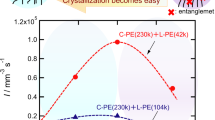Summary
Solution grown polyethylene shish-kebabs have a core, diameter 20–30 nm, which is highly superheatable. When a mat of shish-kebabs is heated to 132 °C the lamellar material melts, leaving birefringent fibres in an isotropic matrix as seen under the polarizing microscope. Microscopic observations reveal that these fibres, aggregates of many shish-kebabs, contract as they are melted and extend on subsequent recrystallization from the partially molten state as the temperature is lowered. This extension is completely reversible on temperature cycling. For fibres originally crystallized at below 96 °C this effect results in crimping on recrystallization and straightening from the crimped state on remelting. This is because these latter fibres are isolated from each other by the lamellar overgrowth and they buckle rather than extending the sample. Analogous reversible length changes and crimping effects were observed also in fibrous crystals produced from the melt.
The above observations allow certain conclusions to be reached as regards the nature of the shish-kebab fibres. Thus an estimate of the forces involved in the bucking indicates that the basic unit which buckles is less than 50 nm in diameter in agreement with the single shish-kebab core when this is directly observable. Similar buckling in the melt crystallized fibrous entities indicates a core of similar size, which is not so easily seen. Further, the observed shrinkage behaviour, together with the associated birefringence and calorimetric information collected in this study, can only be accounted for if melting is visualised as the formation of disordered amorphous regions which alternate with perfect crystal regions along the shish-kebab core. This leads to a model equivalent to a linked row of fringed micelles within a given fibre. The chain straightening of the amorphous sections on recrystallization would then be responsible for the fibre extension. It follows further that for the amorphous sections to form in the first instance there must be preexisting centres of imperfections along the fibre. A model of randomly distributed imperfections (visualised as interlocking chain loops) can account for the present observations in a quantitative manner with realistic predictions as regards the lengths of the undisturbed crystal regions.
Finally there is an obvious analogy with the crystallization of oriented polymer networks (e.g. stretched rubber) as regards the observed extension —contraction behaviour, providing a link between recent findings and long established experience.
Similar content being viewed by others
References
Pennings, A. J., A. M. Kiel, Kolloid Z. u. Z. Polymere205. 160 (1965).
Pennings, A. J., J. M. A. A. van der Mark, H. C. Booij, Kolloid Z. u. Z. Polymere236, 99 (1970).
Frank, F. C., A. Keller, M. R. Mackley, Polymer12, 467 (1971).
Pennings, A. J., in: Crystal Growth, Proc. Int. Conf. on Crystal Growth (Oxford 1966).
Wunderlich, B., C. M. Cormier, A. Keller, M. J. Machin, J. Macromol. Sci.B1, 93 (1967).
Keller, A., F. M. Willmouth, J. Macromol. Sci.B6, 493 (1972).
Pennings, A. J., J. M. M. A. van der Mark, Rheol. Acta10, 174 (1974).
Huseby, T. W., H. E. Bair, Polymer Letters5, 265 (1967).
Rijke, A. M., L. Mandelkern, J. Polymer Sci. A28, 255 (1970).
Wikjord, A. G., R. St, John Manley, J. Macromol. Sci.B2, 501 (1968).
Grubb, D. T., J. A. Odell, A. Keller, J. Mater. Sci.10, 1510 (1975).
Czornyj, G., B. Wunderlich, Makromol. Chem.178, 843 (1977).
Zwijnenberg, A., A. J. Pennings, Colloid and Polymer Sci.254, 868 (1976).
Mackley, M. R. A. Keller, Polymer14, 16 (1973).
Cappaccio, G., I. M. Ward, Nature Phys. Sci.243, 143 (1973).
Cappaccio, G., I. M. Ward, Polymer15, 233 (1974).
Barham, P. J., A. Keller, J. Mater Sci.11, 27 (1976).
A. J. Pennings, C. J. H. Schouteten, A. M. Kiel, J. Polymer Sci.C, 38, 167 (1972).
Bunn, C. W., R. de P. Daubeny, Trans. Faraday Soc.59, 1173 (1954).
Diamant, J., A. Keller, E. Baer, M. Litt, R. G. C. Arridge, Proc. Roy. Soc. Lond.B180, 293 (1972).
Dale, W. C., E. Baer, J. Mater. Sci.9, 369 (1974).
Meyer, K. H., C. Ferri, Helv. Chim. Acta.18, 570 (1935).
Wood, L. A., F. C. Roth, J. Appl. Phys.15, 781 (1944).
Smith, W. H., C. P. Saylor, J. Nat. Bur. Stand.21, 257 (1938).
Tobolsky, A. V., G. M. Brown, J. Polymer Sci.17, 547 (1955).
Roberts, D. E., L. Mandelkern, J. Amer. Chem. Soc.80 1289, (1958).
Oth, J. F. M., P. J. Flory, J. Amer. Chem. Soc.80, 1297 (1958).
Mandelkern, L., D. E. Roberts, A. F. Diorio, A. S. Posner, J. Amer. Chem. Soc.81, 4148 (1959).
Flory, P. J., J. Chem. Phys.15, 397 (1947).
Flory, P. J., J. Amer. Chem. Soc.78, 5222 (1956).
Freund, E., F. Deutsch, Rayon Textile Monthly40, 280 (1940).
T. C. Majury, H. J. Wellard, Atti del Simposio Internationale di Chimica Macromolecolare (1954). Supplemento a La Ricerca Scientifica p. 354, (1955).
Jeffries, R., H. J. Wellard, J. Textile Institute47 1549 (1956).
Girolamo, M., A. Keller, K. Miyasaka, N. Overbergh, J. Polymer Sci. Polym. Phys. Edn.14, 39 (1976).
Zachmann, H. G., Kolloid Z. u. Z. Polymere216-217, 180 (1967).
Zachmann, H. G., Kolloid Z. u. Z. Polymere231, 504 (1969).
M. R. Mackley, A. Keller, Phil. Trans. Roy. Soc.A 278, 29 (1975).
Nagasawa, T., K. Kobayashi, J. Appl. Phys.41, 4276 (1970).
Predecki, P., W. O., Statton, Appl. Polymer Symp.6., 165 (1967).
Discussion Remarks byJ. D. Hoffman.
McHugh, A. J., E. H. Forrest, J. Macromol. Sci. Phys.B11, 219 (1975).
Author information
Authors and Affiliations
Additional information
With 12 figures and 1 table
Rights and permissions
About this article
Cite this article
Grubb, D.T., Keller, A. Thermal contraction and extension in fibrous crystals of polyethylene. Colloid & Polymer Sci 256, 218–233 (1978). https://doi.org/10.1007/BF01550552
Received:
Issue Date:
DOI: https://doi.org/10.1007/BF01550552




